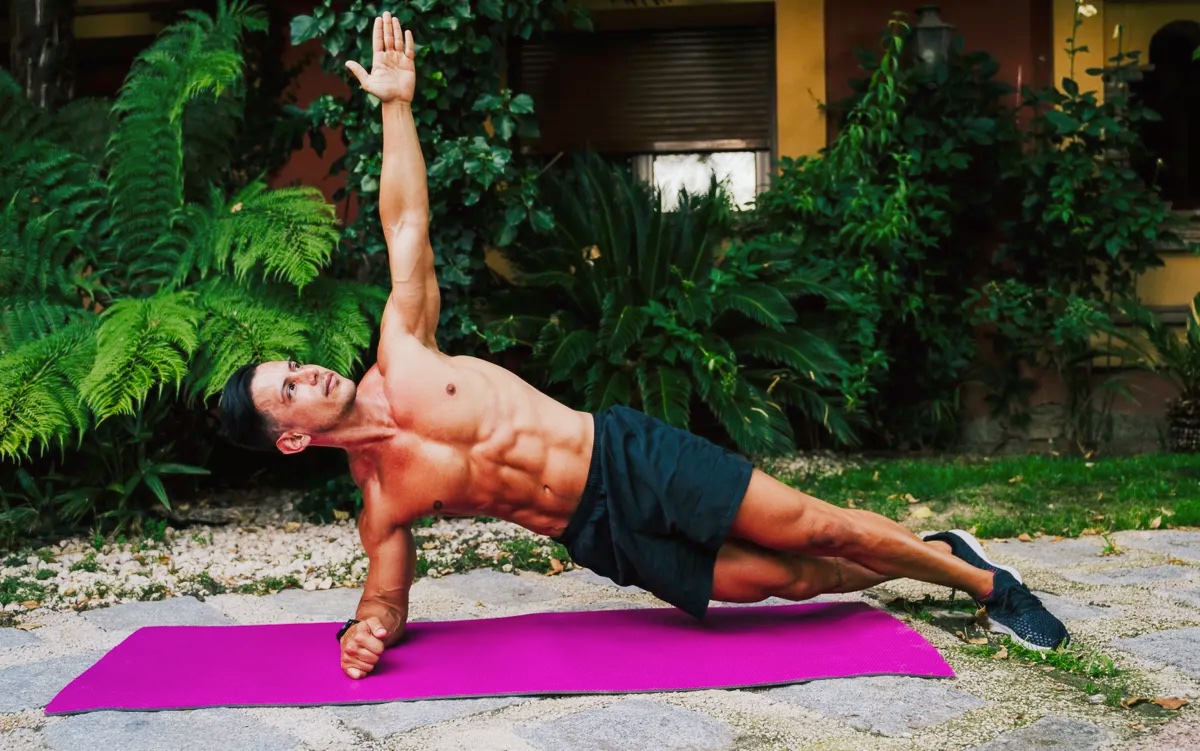I did 30 side planks with a lateral raise every day for a week — here's what happened to my body
1 move, 1 dumbbell to build a stronger core

The plank is, after a short time, a pretty boring move. It's hugely effective for building the core, developing strength and endurance, and reducing lower back pain, but even its fans must admit that it’s kind of dull.
For that reason, I prefer the variations on the basic move, like plank hip dips, so when another one came my way in the form of a side plank with lateral raises, I was practically gung-ho. I really ought to calm down.
You don't need much to get started either; one of the best yoga mats, a bit of space, and an adjustable dumbbell.
What is the side plank with lateral raise?
The most common version of the plank is where you balance on your toes and forearms, and counting down the seconds until you can drop to the floor. But this doesn’t target the obliques, the layers (internal and external) of muscle along the side of your core.
These muscles provide stability, are used for rotating and bending the trunk, and even help force air from the lungs when you exhale. The side plank is a great move for working these crucial, often overlooked, muscles.
The lateral raise — holding a dumbbell in the top arm and raising until that arm is straight — makes a challenging move far harder, even with a light weight. This part of the exercise targets the lateral, or side, deltoid muscles in the shoulder, which help move the arm up and down, and from side to side.
These are the muscles that give shoulders their rounded appearance. The bigger these muscles, the wider your shoulders will look. Of course, lifting a weight like this can challenge your stability, so you may prefer to just lift your arm initially as you get used to the position before adding the weight in.
The lateral raise also makes your core muscles work harder, as the movement of raising and lowering the arm in a controlled manner adds to the general instability that comes from balancing on one side.
How do you do the side plank with lateral raise?
- Lie on your right side, legs straight and stacked on top of each other. Hold a dumbbell in your left hand.
- Place your right elbow under your right shoulder, forearm flat on the floor and perpendicular to your body.
- Brace your core and lift your hips off the floor, so you form a straight line from ankles to head. Your left arm will be resting on your left side.
- You will be supporting your weight on your right forearm and the side of your right foot. I strongly recommend using a soft mat for this move, because it will be deeply uncomfortable otherwise.
- From here, raise your left arm straight up, maintaining good side plank form. Don’t extend your arm past your head, as this places too much stress on the shoulder.
- Lower your arm with control back to your side. That’s one rep.
Aim for two or three sets of 5-10 to begin with (this is harder than it sounds). As ever, if you feel any pain, stop. It’s amazingly easy to damage the shoulder.
I don’t do the side plank often. I prefer the Russian twist or, when I know no one can see me, the bird dog, when I want to work my obliques. I didn’t think adding the lateral raise would pose a problem and, once again, I was dead wrong.
Watch the weight
I thought a 10lbs dumbbell was about right — not so light that I’d be wasting my time, and not so heavy that I’d be risking injury — but it was a struggle. There’s a big difference between lifting a 10lbs out to the side from a standing position and raising one to the sky while in side plank position.
On the first day, I completed three sets of 10 on each side (swapping sides after each 10), but was breathing heavily by the end and the final few reps were an abomination of form. I was surprised and a little disappointed.
I suggest you use a lighter weight than you think is necessary and be careful it doesn’t pull your arm beyond your head; your arm should be high, straight and steady at the top of the move. I felt the exercise in my chest, upper back, upper arm (not just the shoulder), and core.
One more thing to be aware of: make sure you properly engage your core when you get into the plank position. It’s easy to forget when you’re focused on lifting the weight, but getting the core involved will make it far easier (relatively speaking) to complete the sets.
Progress was slow
By day three I was up to three sets of 12, with 30 seconds between efforts. This didn’t seem much of an improvement, but the lateral raise was proving far more arduous than I’d imagined.
I told myself I’d be amazed I could reach three sets of 15 by the end of the week, which was hardly the right attitude, but I truly was not confident I could add to my reps.
I persevered with the 10lb weight because I fancied testing myself and was sure it was not so heavy as to cause me injury. Some of these challenges get easier as the days pass; this one did not, though I hit three sets of 15 on day five (after a day off, owing to life getting in the way). And then, on the last day, I decided to try for 20 on the final set for each side.
I did this in part to prove something to myself and in part because my girlfriend was watching. And I hit the target, though I’m not sure which of these two incentives was the primary driver. Then again, my girlfriend gave me a pat on the head, so I think I do know the answer.
My take on the side plank with lateral raise
I enjoy being challenged by these exercises, but this was more of a test than I had expected and I admit I didn’t have a song in my heart each day when I pulled out the mat and dumbbell. But isn’t that the mark of a good challenge?
This one made me work, made me question myself, and made me try just that little more. The side plank with lateral raise is not one for beginners, but if you want to work on your obliques and your shoulders at the same time (and who among us doesn’t?), this is an excellent way to do it.
And if no one is around when you hit a target, give yourself a pat on the head. But put the dumbbell down first.
More from Tom's Guide
Sign up to get the BEST of Tom's Guide direct to your inbox.
Get instant access to breaking news, the hottest reviews, great deals and helpful tips.
John is a writer and editor based in London. He was worked for magazines such as Runner’s World, Men’s Health, Women’s Health and Cosmopolitan. A keen runner, what he lacks in ability he makes up for with enthusiasm and excuses.


